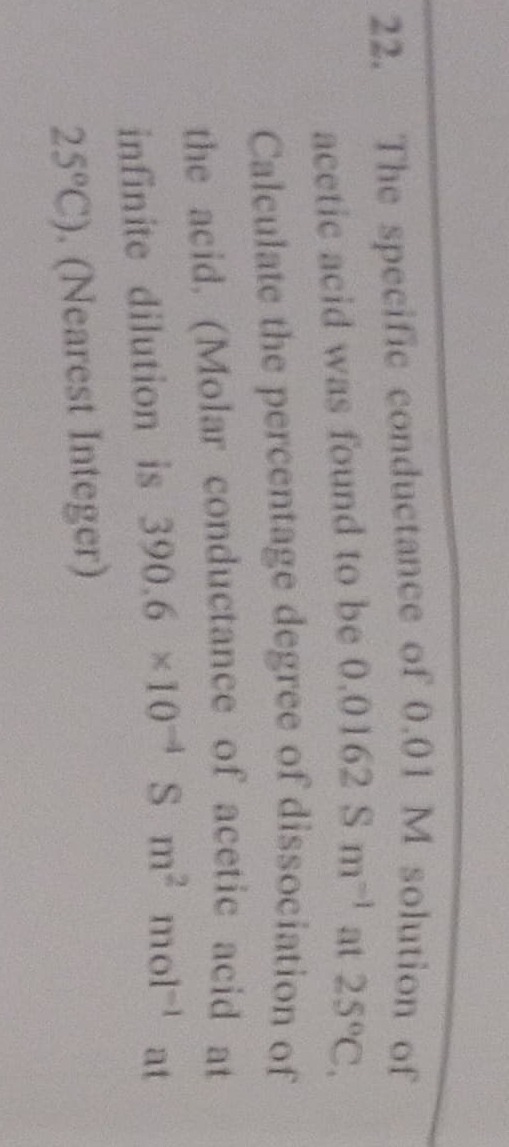Question
Question: The specific conductance of 0.01 M solution of acetic acid was found to be 0.0162 S m⁻¹ at 25°C. Cal...
The specific conductance of 0.01 M solution of acetic acid was found to be 0.0162 S m⁻¹ at 25°C. Calculate the percentage degree of dissociation of the acid. (Molar conductance of acetic acid at infinite dilution is 390.6 ×10⁻⁴ S m² mol⁻¹ at 25°C). (Nearest Integer)

4
Solution
To calculate the percentage degree of dissociation of acetic acid, we follow these steps:
-
Convert the concentration units:
The given concentration is in M (mol L⁻¹), and specific conductance is in S m⁻¹, while molar conductance at infinite dilution is in S m² mol⁻¹. To ensure consistent units, we convert the concentration from mol L⁻¹ to mol m⁻³.
1 L=10−3 m3
So, 0.01 M=0.01 mol L−1=0.01 mol/(10−3 m3)=10 mol m−3 -
Calculate the molar conductance (Λm) at the given concentration:
The formula for molar conductance is:
Λm=Cκ
where κ is the specific conductance and C is the concentration.
Given κ=0.0162 S m−1 and C=10 mol m−3.
Λm=10 mol m−30.0162 S m−1=0.00162 S m2 mol−1 -
Calculate the degree of dissociation (α):
The degree of dissociation is given by the ratio of molar conductance at a given concentration to the molar conductance at infinite dilution:
α=Λm∘Λm
Given Λm∘=390.6×10−4 S m2 mol−1=0.03906 S m2 mol−1.
α=0.03906 S m2 mol−10.00162 S m2 mol−1=0.0414746... -
Calculate the percentage degree of dissociation:
Percentage degree of dissociation =α×100%
Percentage degree of dissociation =0.0414746...×100%=4.14746...% -
Round to the nearest integer:
Rounding 4.14746...% to the nearest integer gives 4%.
The final answer is 4.
Explanation of the solution:
- Convert concentration from mol/L to mol/m³: 0.01 M=10 mol m−3.
- Calculate molar conductance at given concentration: Λm=κ/C=0.0162 S m−1/10 mol m−3=0.00162 S m2 mol−1.
- Calculate degree of dissociation: α=Λm/Λm∘=0.00162 S m2 mol−1/(390.6×10−4 S m2 mol−1)=0.04147.
- Convert to percentage: Percentage α=0.04147×100%=4.147%.
- Round to the nearest integer: 4%.
